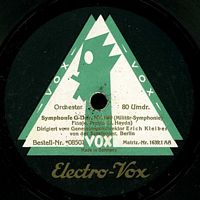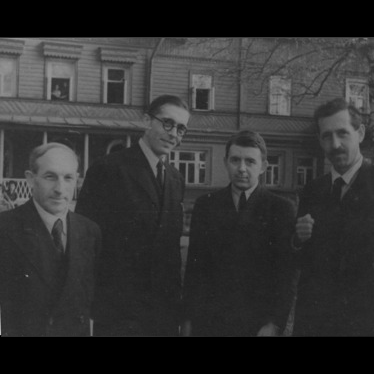Étiquette : Schubert
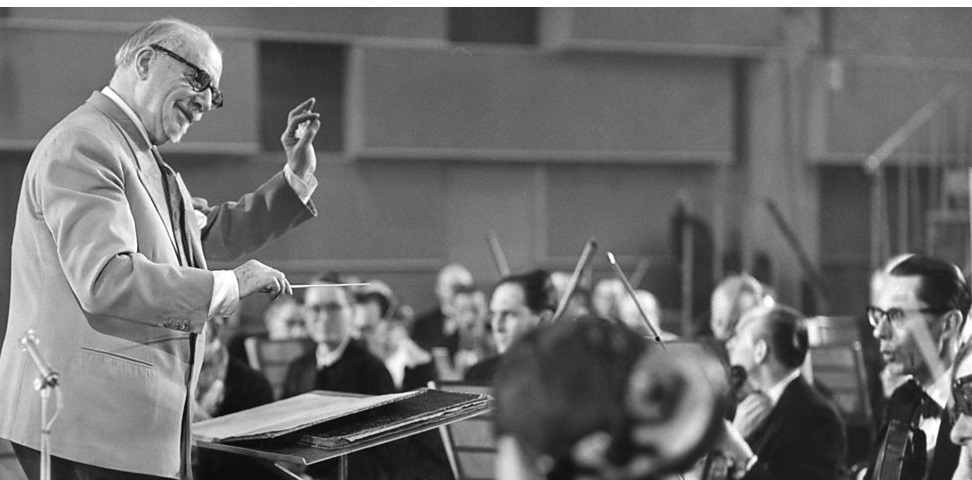
Schubert Symphony n°6 D.589
Sir Thomas Beecham – Royal Philharmonic Orchestra (RPO)
London Abbey Road Studio n°1 – 25 & 26 November, 15 December 1955
Source Bande/Tape Columbia BTA104: 2 pistes/19 cm/s / 2 tracks 7.5 ips STEREO
Sir Thomas Beecham a dirigé toutes les symphonies de Schubert, ce qui était rare à l’époque, et il les a aussi enregistrées pour le disque, à l’exception des n°4 et n°9. Il lui arrivait souvent d’enregistrer une œuvre lors de plusieurs séances qui pouvaient être espacées de plusieurs mois, et parfois une même œuvre pouvait être enregistrée dans deux lieux différents comme ça a été le cas en 1951 pour la Symphonie n°8 (Kingsway Hall et Studio n°1 Abbey Road) et en 1958 -59 pour les symphonies n°3 et 5 (Salle Wagram à Paris et Studio n°1 Abbey Road à Londres).
La bande stéréophonique (‘Stereosonic’) BTA104 a été publiée début mai 1956, en même temps que le microsillon mono, soit à peine quelques mois après les séances d’enregistrement.
Pour les symphonies, les dates des enregistrements par Beecham sont les suivantes:
–n°1 D.82: RPO Walthamstow Town Hall 7 décembre 1953
–n°2 D.125: RPO Walthamstow Town Hall 28 avril 1954
–n°3 D.200: RPO Salle Wagram 12 mai 1958, Studio n°1 Abbey Road 22 mai 1958 et 2 mai 1959 ; RPO (en public) Royal Festival Hall 15 octobre 1958
–n°5 D.485: LPO Kingsway Hall 15 décembre 1938 et 11 janvier 1939; RPO Salle Wagram 14 et 16 mai 1958, Studio n°1 Abbey Road 18 décembre 1958 et 7 mai 1959
–n°6 D.589: LPO Studio n°1 Abbey Road 28 novembre et 18 décembre 1944; RPO Studio n°1 Abbey Road 25, 26 novembre et 15 décembre 1955.
–n°8 D.759: LPO Studio n°1 Abbey Road 12 octobre et 1 novembre 1937; RPO Kingsway Hall 15 et 24 janvier, 11 et 23 juillet 1951, Studio n°1 Abbey Road 9 mai 1951
–n°9 D.944: RPO (en public) Royal Festival Hall 14 décembre 1955
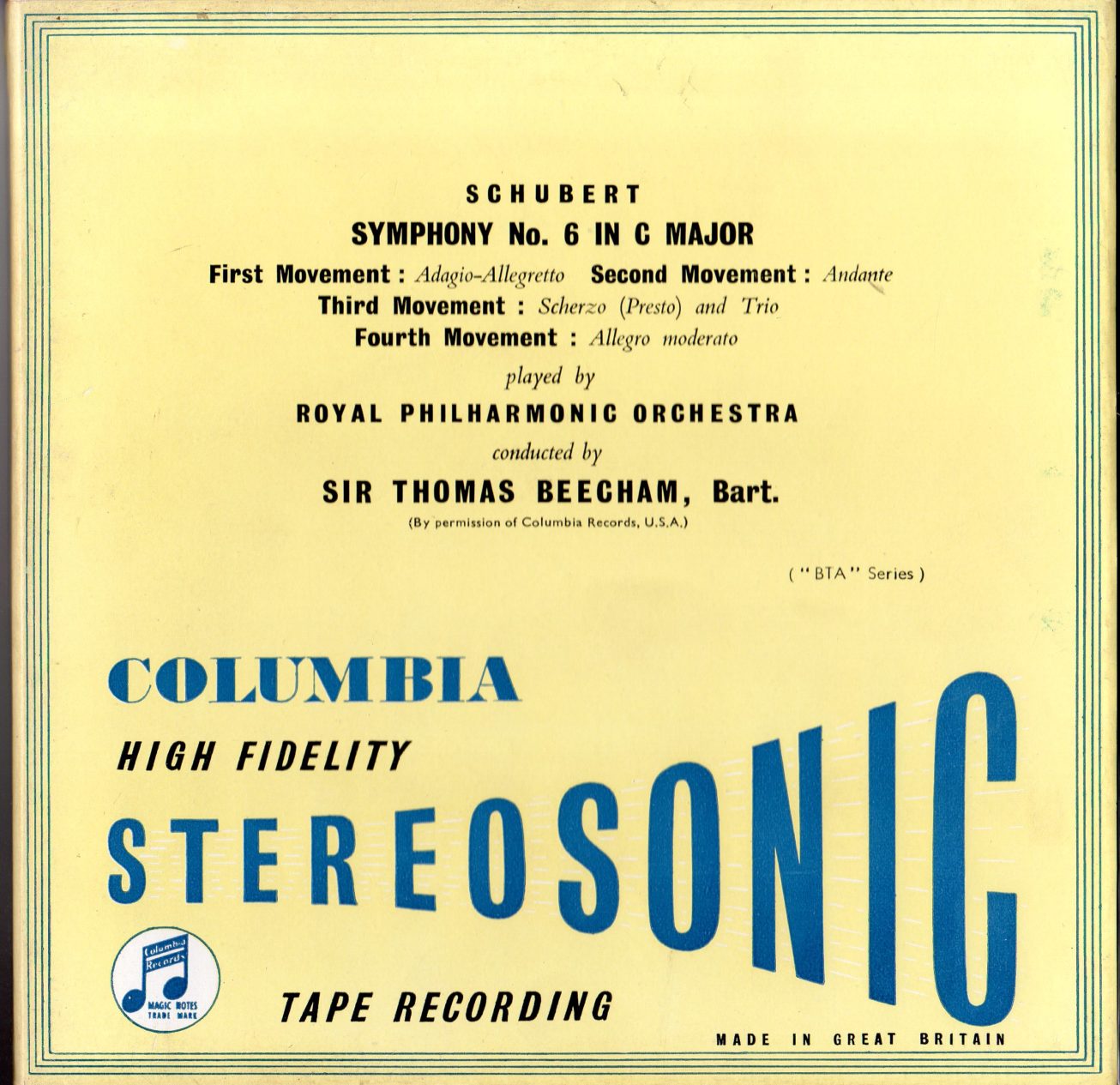

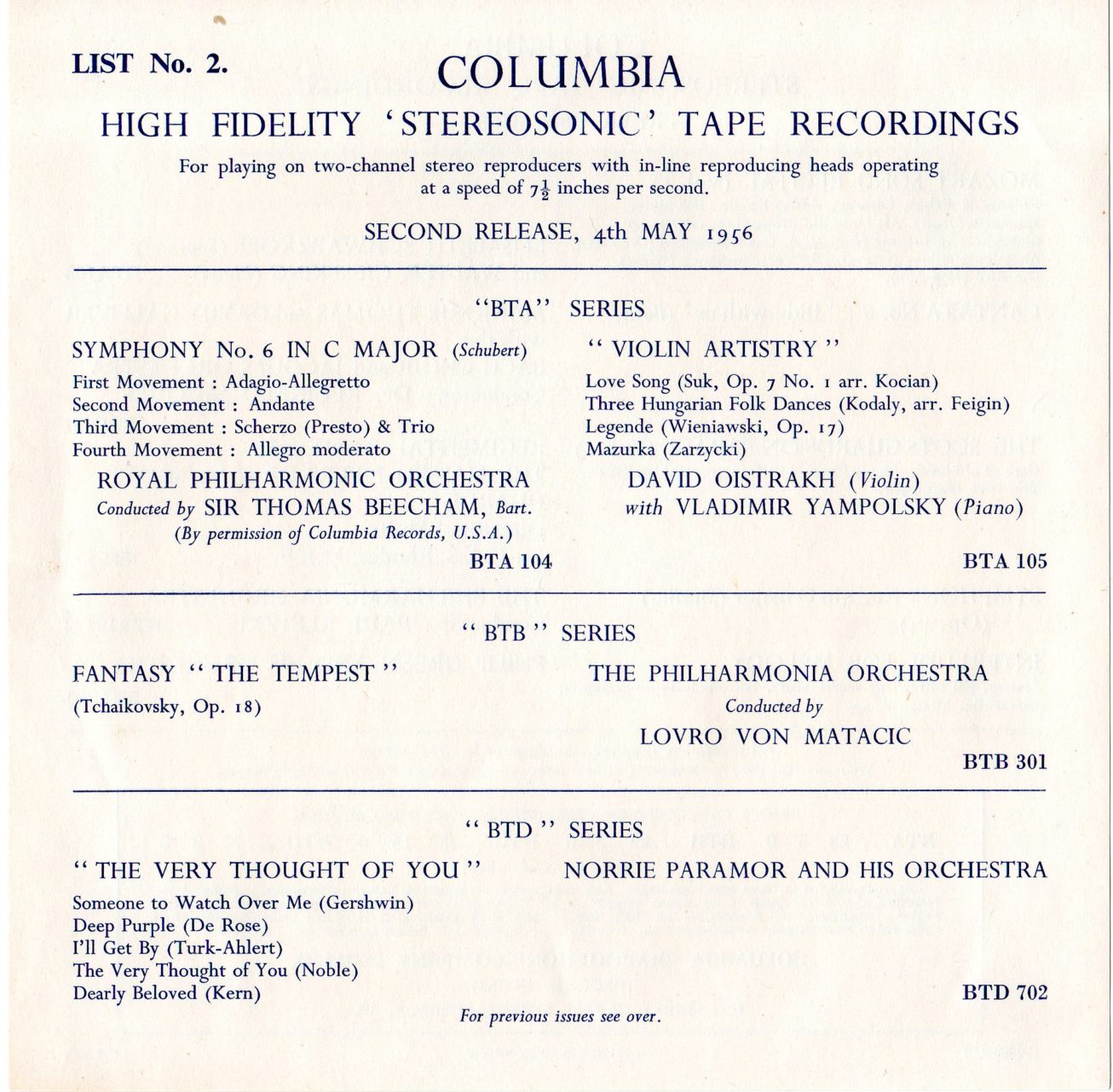
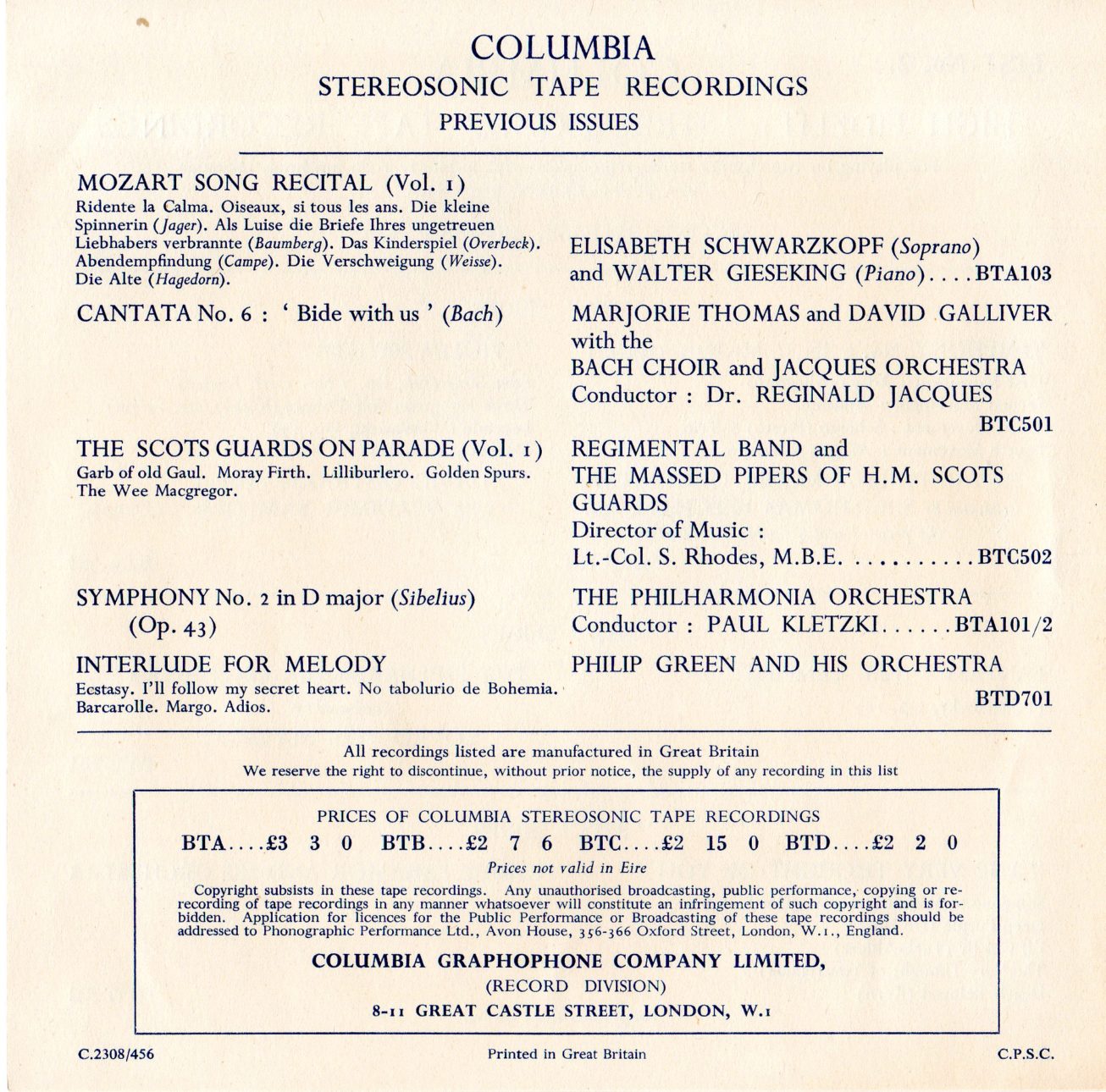
Sir Thomas Beecham conducted all of Schubert’s symphonies, which was rare at the time, and he also recorded them for the disc, with the exception of n°4 and 9. He often recorded a work in several sessions several months apart, and sometimes the same work was recorded in two different venues, as was the case in 1951 for Symphony n°8 (Kingsway Hall and Studio n°1 Abbey Road) and in 1958-59 for Symphonies Nos. 3 and 5 (Salle Wagram in Paris and Studio n°1 Abbey Road in London).
The BTA104 stereophonic (‘Stereosonic’) tape was released in early May 1956, at the same time as the mono LP, just a few months after the recording sessions.
For the symphonies, Beecham’s recording dates are as follows:
–n°1 D.82: RPO Walthamstow Town Hall 7 December 1953
–n°2 D.125: RPO Walthamstow Town Hall 28 April 1954
–n°3 D.200: RPO Salle Wagram 12 May 1958, Studio n°1 Abbey Road 22 May 1958 and 2 May 1959; RPO (live) Royal Festival Hall 15 October 1958
–n°5 D.485: LPO Kingsway Hall 15 December 1938 and 11 January 1939; RPO Salle Wagram 14 and 16 May 1958, Studio n°1 Abbey Road 18 December 1958 and 7 May 1959
–n°6 D.589: LPO Studio n°1 Abbey Road 28 November and 18 December 1944; RPO Studio n°1 Abbey Road 25, 26 November and 15 December 1955.
–n°8 D.759: LPO Studio n°1 Abbey Road 12 October and 1 November 1937; RPO Kingsway Hall 15 and 24 January, 11 and 23 July 1951, Studio n°1 Abbey Road 9 May 1951.
–n° 9 D.944: RPO (live) Royal Festival Hall 14 December 1955
Les liens de téléchargement sont dans le premier commentaire. The download links are in the first comment
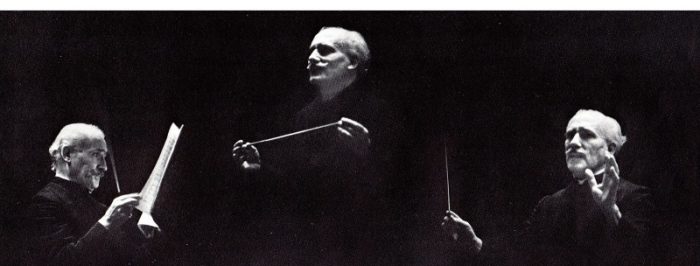
Arturo Toscanini – Philadelphia Orchestra
Schubert Symphony n°9 D.944
Academy of Music – November 16, 1941
Prod: Charles O’Connell – Eng: Fred Lynch
Source: 33t/LP RCA Album 5LP RL 01900(5)

Les problèmes techniques qu’ont connus ces enregistrements au cours des étapes techniques jusqu’à l’obtention des épreuves 78 tours sont bien connus, notamment du livre de Charles O’Connell, ‘The Other Side of the Record’, du texte de David Hall qui accompagne le coffret RL 01900(5) de 1976 consacré à la première publication de l’ensemble des enregistrements de Toscanini à Philadelphie et de l’article consacré à ce coffret par Harris Goldsmith et paru en janvier 1977 (High Fidelity).
Qu’il ait été possible d’obtenir un résultat final apte à restituer le génie de ces interprétations tient, nous dit-on, presque du miracle.
Selon Harris Goldsmith (High Fidelity, janvier 1977 pages 103-105) : ‘La collaboration avec Toscanini fonctionne peut-être le mieux dans la symphonie de Schubert. Cette interprétation – richement lyrique, souple dans le tempo, dramatique à couper le souffle (très différente des deux enregistrements ultérieurs avec le NBC Symphony) – est tout simplement la meilleure que j’aie jamais entendue’.
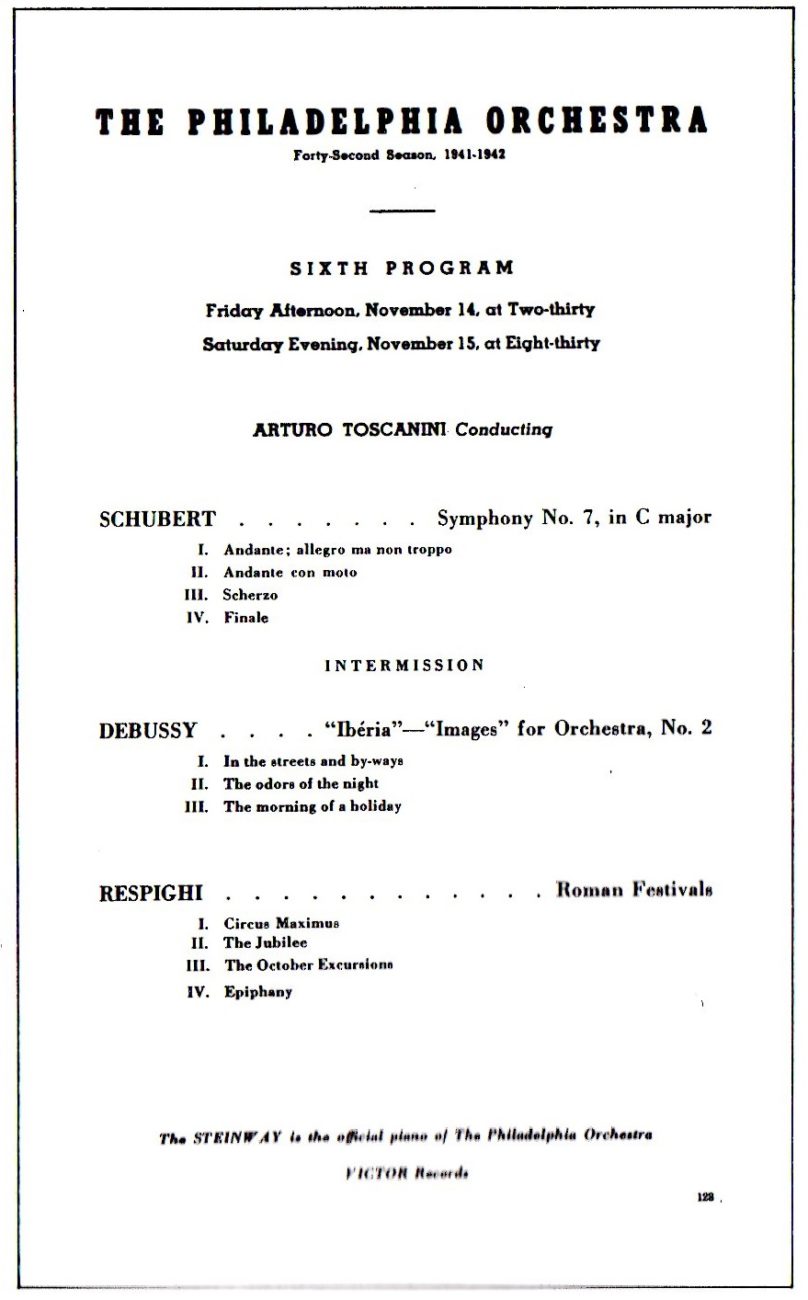
Schubert: Séance d’enregistrement / Recording Session (Academy of Music)
Cliquer sur l’image pour l’agrandir / Click on the picture to enlarge
The technical problems that these recordings experienced during the technical stages until the 78 rpm test pressings were obtained are well known, especially from Charles O’Connell’s book, ‘The Other Side of the Record’, from the text by David Hall that accompanies the 1976 boxed set RL 01900(5) devoted to the first publication of all of the Toscanini’s recordings in Philadelphia, and from the article dedicated to this box set by Harris Goldsmith and published in January 1977 (High Fidelity).
That it was possible to obtain a final result able to restore the genius of these interpretations is, as we are told, almost a miracle.
According to Harris Goldsmith (High Fidelity January 1977 pages 103-105): ‘The collaboration with Toscanini perhaps works best in the Schubert symphony. This performance – richly lyrical, flexible in tempo, hairraisingly dramatic (quite different from the two later recordings with the NBC Symphony)- is simply the greatest I have ever heard.’
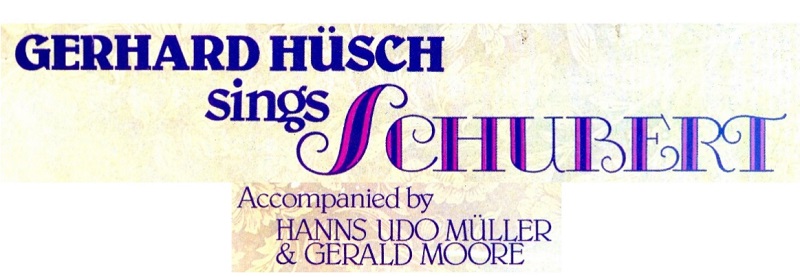
Gerhard Hüsch – Hanns-Udo Müller & Gerald Moore (D.957 n° 7, 10, 12 & 14)
Source: 33t/LP World Records Retrospect Series SHB 65 (1980)
Enregistrement/ Recording: Berlin 1934-1939
Report/Transfer: Keith Hardwick

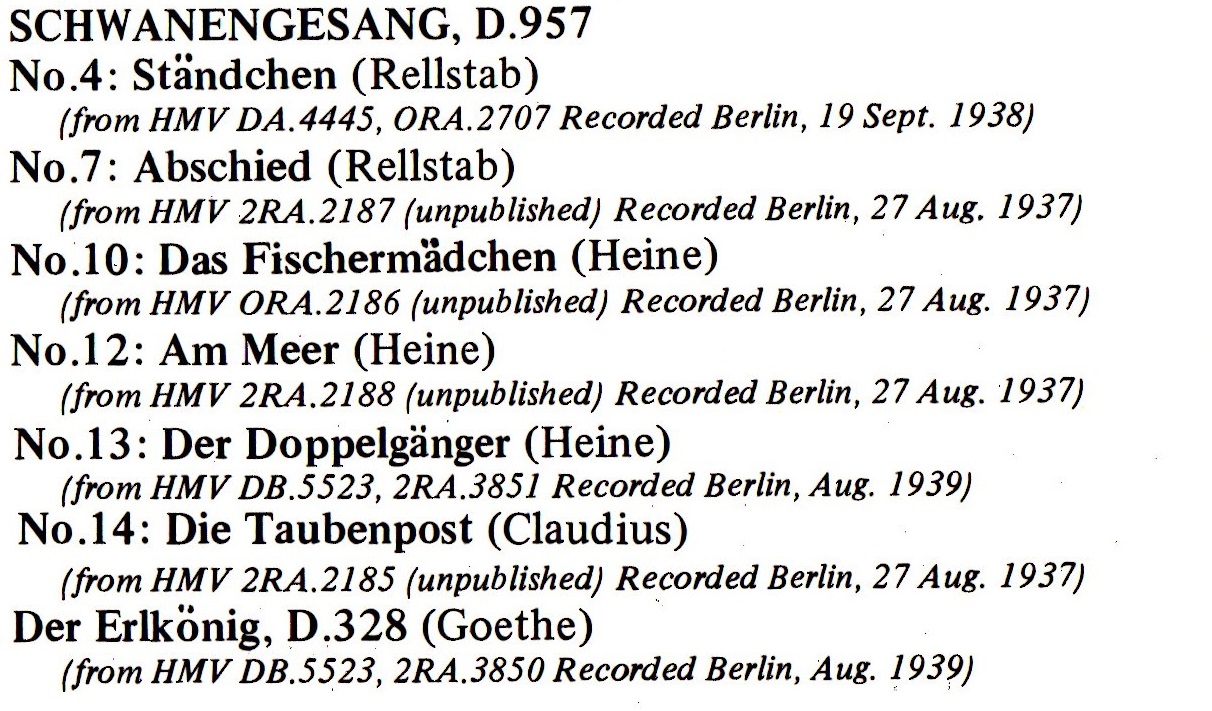
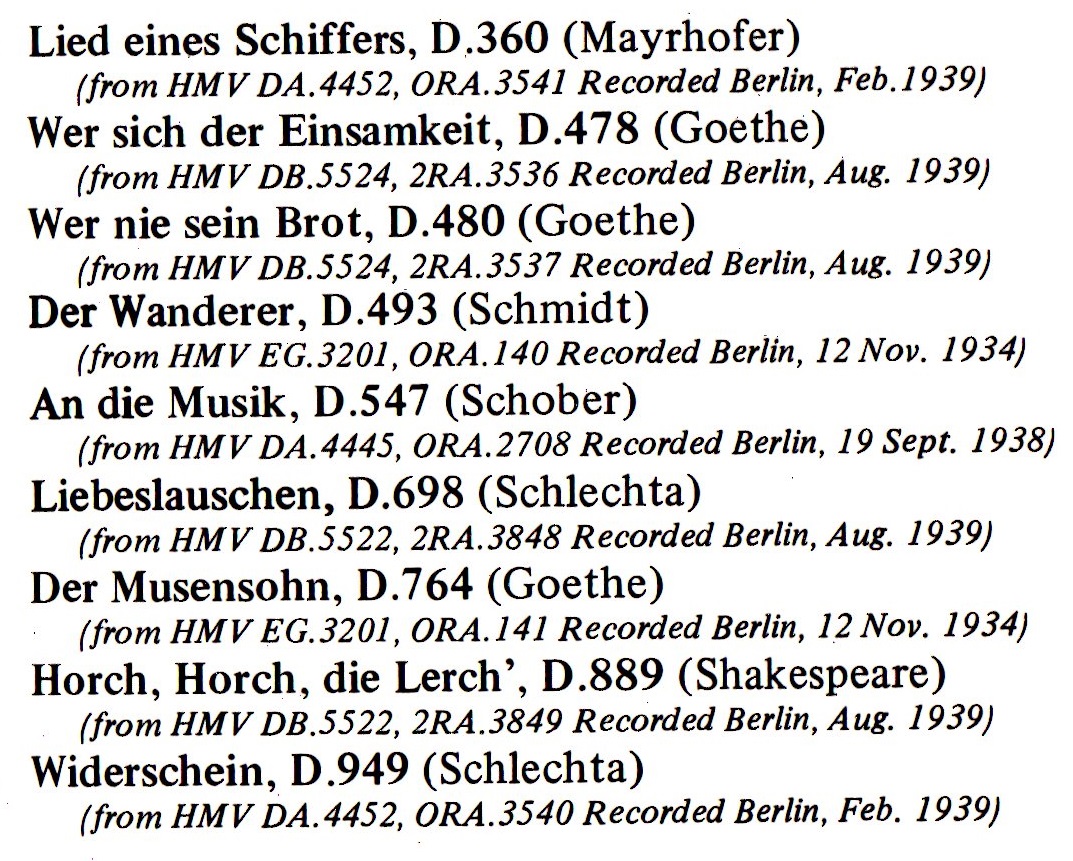
A part les cycles ‘Die schöne Müllerin ‘ et ‘Die Winterreise’ Gerhard Hüsch a enregistré avant-guerre un certain nombre de Lieder de Schubert dont 6 sont issus du recueil ‘Schwanengesang’ D.957 en y incluant Die Taubenpost (D.957 ‘n°14’ = D.965A). Trois de ces Lieder sont sur des poèmes de Heine, que le régime nazi n’allait pas tarder à interdire complètement.
Le texte joint au disque comporte quelques erreurs notamment sur les numéros de catalogue Deutsch qui ont été corrigés dans les fichiers numériques sur la base des informations de l’indispensable site https://www.schubertsong.uk .

Apart from the ‘Die schöne Müllerin’ and ‘Die Winterreise’ cycles, Gerhard Hüsch recorded a number of Schubert songs before the war, six of which are from the collection ‘Schwanengesang’ D.957 if we include Die Taubenpost (D.957 ‘n°14’ = D.965A). Three of these songs are set to poems by Heine, which the Nazi regime was soon to ban completely.
The text accompanying the disc contains a few errors, notably in the Deutsch catalogue numbers, which have been corrected in the digital files on the basis of information from the indispensable website https://www.schubertsong.uk/.

Peter Anders, tenor Michael Raucheisen, piano; Hans Berger, horn (D.943)
Enregistrement / Recording: Berlin Haus des Rundfunks (Masurenallee)
Einsamkeit D.620; Der Liedler D.209: 1942
Auf dem Strom D.943: 1943
Erwartung D.159: 2 November 1944
Sources: 33t/LP: Acanta 40.23.056 (1977) Einsamkeit D.620;
Melodiya M10 46681 005 (1985) Der Liedler D.209, Auf dem Strom D.943
CD: TAH 201-202 Erwartung D.159
Un programme d’une heure de musique avec seulement 4 Lieder de Schubert, voilà qui a de quoi surprendre!
Une grande originalité quoique peu connue de Schubert est qu’il a composé plus d’une dizaine de Lieder dont la durée dépasse nettement les dix minutes, voire, pour certains d’entre eux, les quinze minutes.
On connaît bien sûr ‘Der Hirt auf dem Felsen’, mais il existe deux Lieder précoces très étonnants sur des textes de Schiller, la ‘Leichenfantasie’ D.7 de 1811 (19 minutes) et ‘Der Taucher’ D.77 de 1813 (24 minutes). D’autres compositions dans cette veine ont suivi: Der Liedler D.209 sur un poème de Kenner (16’) et Die Bürgschaft D.246 sur un poème de Schiller (17’) en 1815, Erwartung D.159 de nouveau sur un poème de Schiller (15’) en 1816, puis en 1818 un Lied de grande envergure qu’il considérait comme le meilleur qu’il ait jamais composé: Einsamkeit D.620 sur un poème de Mayrhofer (19’).
Pour sa monumentale série d’enregistrements réalisée pour la Radio de Berlin entre 1942 et 1945, Michael Raucheisen a eu l’idée brillante de mettre à profit la mise en service à partir de 1942 des Magnetophon, dont les bandes magnétiques permettaient jusqu’à 22 minutes de musique en continu, pour enregistrer pour la première fois, avec Peter Anders, dont la voix de ténor lyrique au timbre superbe, paraissait en effet idéale, trois de ces Lieder: Einsamkeit D.620 (18’44), Der Liedler D.209 (15’49) et Erwartung D.159 (15’07), de très grandes interprétations.
Il est étonnant qu’ensuite, les interprètes de Lieder n’aient pas considéré ces œuvres à leur juste valeur, et n’aient pas non plus songé à les regrouper pour former un programme, et qu’elles n’aient été enregistrées que dans le cadre de grandes anthologies ou d’intégrales.
En 1828, Schubert a composé Auf dem Strom D.943 (avec cor ou violoncelle obligé), un très beau Lied d’une dizaine de minutes sur un poème de Rellstab, qui de ce fait aurait pu se retrouver dans le recueil Schwanengesang D.957. Il a été donné en concert le 26 mars 1828 en hommage à Beethoven pour le premier anniversaire de sa mort.
Le corniste Hans Berger (1907-1996) était autrichien et il a commencé sa carrière au Wiener Symphoniker (1927-28). Il a été ensuite cor solo du Gewandhausorchester (1928-29), de l’Orchestre du Berliner Staatsoper (1929-45), puis des Wiener Philharmoniker (WPO) à partir de 1946 jusqu’en 1960. 3ème cor de 1960 à 1965 et 4ème cor de 1965 jusqu’à sa retraite en 1972. Sa réputation était telle que le Boston SO lui a proposé le poste de cor solo en 1936.
N.B. L’indispensable site www.schubertsong.uk donne les textes de tous les Lieder de Schubert ainsi que leur traduction en anglais et des commentaires détaillés par Malcom Wren.
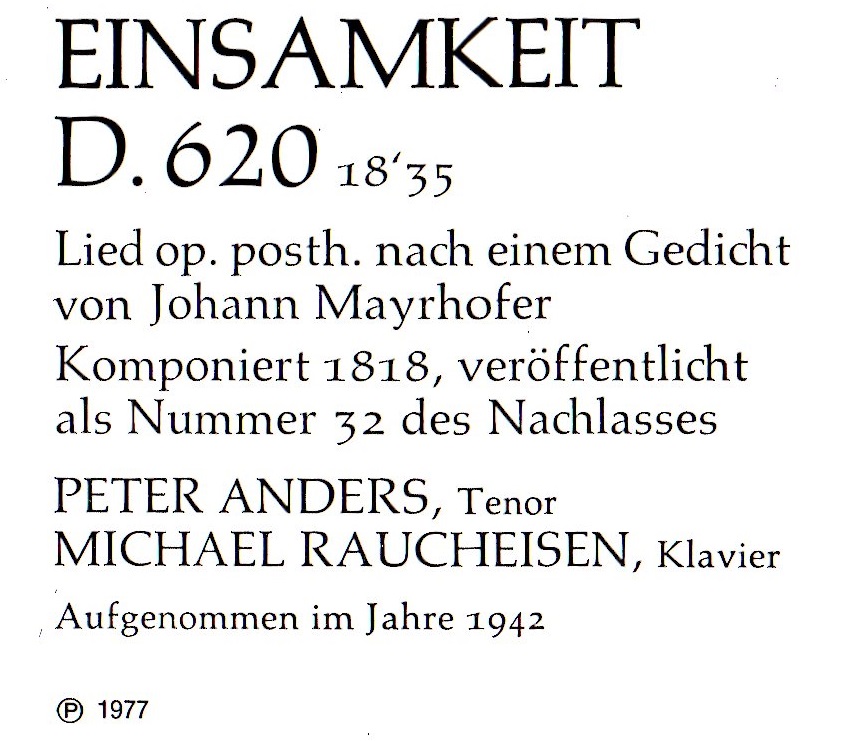
Acanta 40.23.056
____________
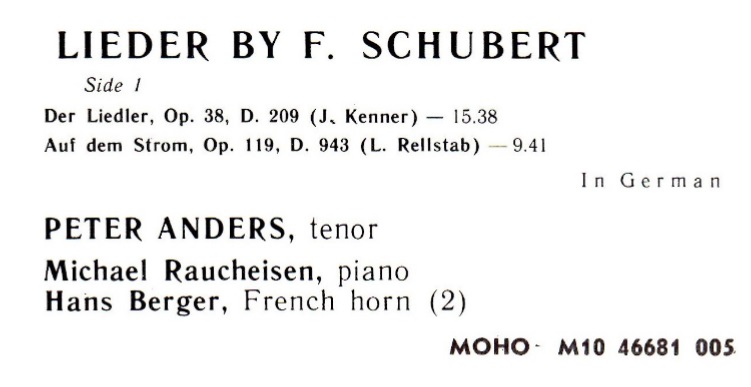
A full hour of music with only 4 Lieder by Schubert, that is somewhat surprising!
A great but rather unknown originality of Schubert is that he composed about a dozen Lieder whose duration clearly exceeds ten minutes, and for some of them even fifteen minutes.
‘Der Hirt auf dem Felsen’ is well known, but there exist two quite astonishing early Lieder on texts by Schiller, namely the ‘Leichenfantasie’ D.7 of 1811 (19 minutes) and ‘Der Taucher’ D.77 of 1813 (24 minutes). Other works in this vein followed: Der Liedler D.209 on a poem by Kenner (16’) and Die Bürgschaft D.246 on a poem by Schiller (17’) in 1815, Erwartung D.159 again on a poem by Schiller (15’) in 1816, and in 1818 an ambitious large-scale Lied which he considered as the best he ever composed: Einsamkeit D.620 on a poem by Mayrhofer (19’).
For his monumental series of recordings made for the Berlin Radio between 1942 and 1945, Michael Raucheisen had this bright idea: take adantage of the implementation in 1942 of the Magnetophon, with magnetic tapes allowing a continuous flow of music up to 22 minutes, to record for the first time ever, with Peter Anders, whose lyrical tenor voice with superb timbre indeed seemed ideal, three of these Lieder: Einsamkeit D.620 (18’44), Der Liedler D.209 (15’49) and Erwartung D.159 (15’07), and these are very great performances.
It is surprising that later on, Lieder singers did not considered these works at their real value, nor thought of grouping them together to build programs, and that they have been recorded mainly in large anthologies or complete recordings.
In 1828, Schubert composed Auf dem Strom D.943 (with horn or cello obbligato), a very beautiful Lied lasting about ten minutes on a poem by Rellstab, which therefore might have been included in the Schwanengesang D.957. It was performed at a public concert on March 26, 1828 as a tribute to Beethoven on the first anniversary of his death.
Hornist Hans Berger (1907-1996) was Austrian and he started his career at the Wiener Symphoniker (1927-28). He was later solo horn of the Gewandhausorchester (1928-29), of the Orchestra of the Berliner Staatsoper (1929-45), then of the Wiener Philharmoniker (WPO) since 1946 until 1960. 3rd horn between 1960 and 1965 et 4th horn from 1965 until his retirement in 1972. His reputation was such that the Boston SO wanted to hire him as solo horn in 1936.
N.B. The indispensable site www.schubertsong.uk gives the texts of all the Lieder by Schubert as well as their English translation and detailed comments by Malcom Wren.

Boskovsky Ensemble – III
HAPPY NEW YEAR 2023 /BONNE ANNEE 2023


Œuvres de Lanner, Mozart, Schubert, et de J. Strauss Sr. et Jr.
Boskovsky Ensemble (chefs de pupitre du WPO)
Violon I : Willi Boskovsky (1908-1991) « Stimmführer » des violons I de 1934 à 1938, puis Konzertmeister de 1938 à 1970
Violin II : Wilhelm Hübner (1914-1996) « Stimmführer » des violons II de 1954 à 1964, « Vorgeiger » ensuite jusqu’en 1980 (retraite)
Violin III et Alto: Rudolf Streng (1915-1988) violon I de 1938 à 1959; alto solo de 1959 à 1980 (retraite)
Contrebasse: Otto Rühm (1906-1979) contrebasse solo de 1955 à 1971 (retraite)
Flûte – Josef Niedermayr (1900-1962) flûte solo de 1933 à 1962
Clarinette – Rudolf Jettel (1903-1981) clarinette solo de 1945 à 1968 (retraite)
Cors: Otto Nitsch (1906-1982) 2ème cor de 1941 à 1971; Roland Berger(1937) 3ème cor au Wiener Staatsoper (1955); cor solo de 1961 à 1984; de nouveau 3ème cor de 1984 à 1993 (retraite)
L’enregistrement a été réalisé en 1960 dans la Festsaal du Casino de Baumgarten.
Source: Bande / Tape VTC-1634 – 4 pistes / 19 cm/s – 4 tracks 7.5 ips
Les œuvres sont les suivantes:
01- Johann Strauss Sr. : Chinesischer Galopp 2 violons, alto, contrebasse, flûte, clarinette, 2 cors
02- Johann Strauss Sr. : Kettenbrücke Walzer 2 violons, contrebasse
03- Johann Strauss Sr. : Eisele und Beisele Sprünge 2 violons, alto, contrebasse, flûte, clarinette, 2 cors
04- Josef Lanner: Styrian Dances 2 violons, alto, contrebasse
05- Wolfgang Amadeus Mozart: 3 Contredanses K.462-1 6&5-24-88 – 2 violons, alto, flûte, clarinette, 2 cors
06- Johann Strauss Jr: Wiener Gemüths 2 violons, alto, contrebasse
07-Wolfgang Amadeus Mozart: 4 Deutsche Tänze K.600 n°3, K.605 n°1, K.686 n°11, K.600 n°1 – 2 violons, alto, flûte, clarinette, 2 cors
08-Franz Schubert: 8 Wälzer und Ländler Op.9 n°2, Op.18 n°1,3, Op.9 n°14,35, Op.33 n°10, Op.127 n°15,18
09-Johann Strauss Jr: Champagne Galopp
10-Josef Lanner: Die Werber Walzer 3 violons, contrebasse
11-Johann Strauss Sr: Cachucha Galopp
Parmi les œuvres de Johann Strauss Sr (1804- 1849), on trouve un de ses premiers grands succès, la ‘Kettenbrücke Walzer’, composée en 1828 pour célébrer le premier pont suspendu (à chaînes) de Vienne, construit à proximité du palais Rasoumovsky et inauguré en 1825, un sujet inattendu pour une valse!
L’ère de la Famille Strauss s’est ainsi ouverte immédiatement après Haydn, Mozart, Beethoven et Schubert qui ont également composé de la musique populaire.
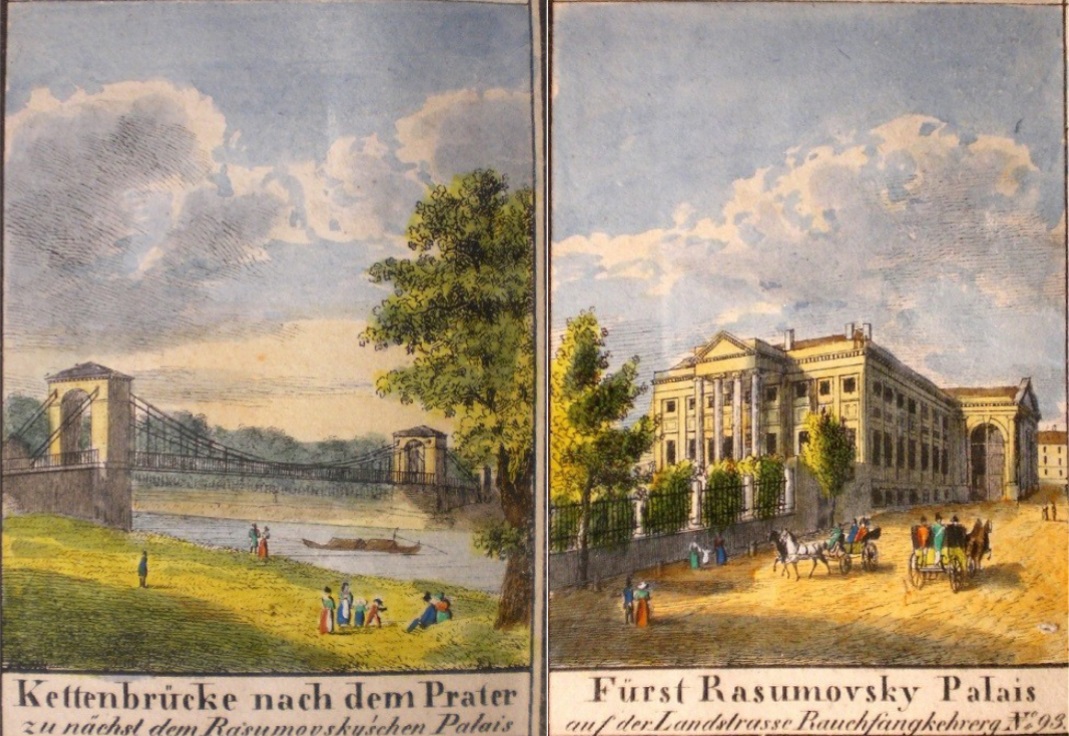
Kettenbrücke beim Palais Rasumovsky nach dem Prater

Works by Lanner, Mozart, Schubert, and by J. Strauss Sr. and Jr.
Boskovsky Ensemble (first desk men of the WPO):
Violin I : Willi Boskovsky (1908-1991) « Stimmführer » of violins I from 1934 to 1938, then Konzertmeister from 1938 to 1970
Violin II : Wilhelm Hübner (1914-1996) « Stimmführer » of violins II from 1954 to 1964, then « Vorgeiger » until 1980 (retirement)
Violin III and Viola: Rudolf Streng (1915-1988) violin I from 1938 to 1959; solo viola from 1959 to 1980 (retirement)
Double-bass: Otto Rühm (1906-1979) solo double-bass from 1955 to 1971 (retirement)
Flute: Josef Niedermayr (1900-1962) in the orchestra since 1921; solo flute from 1933 to 1962
Clarinet: Rudolf Jettel (1903-1981) solo clarinet from 1945 to 1968 (retirement)
Horns: Otto Nitsch (1906-1982) 2nd horn from 1941 to 1971; Roland Berger(1937) 3rd horn at the Wiener Staatsoper (1955); solo horn between 1961 and 1984; then again 3rd horn between 1984 and 1993 (retirement)
The recording was made in 1960 in the Festsaal of the Baumgarten Casino.
Source: Tape VTC-1634
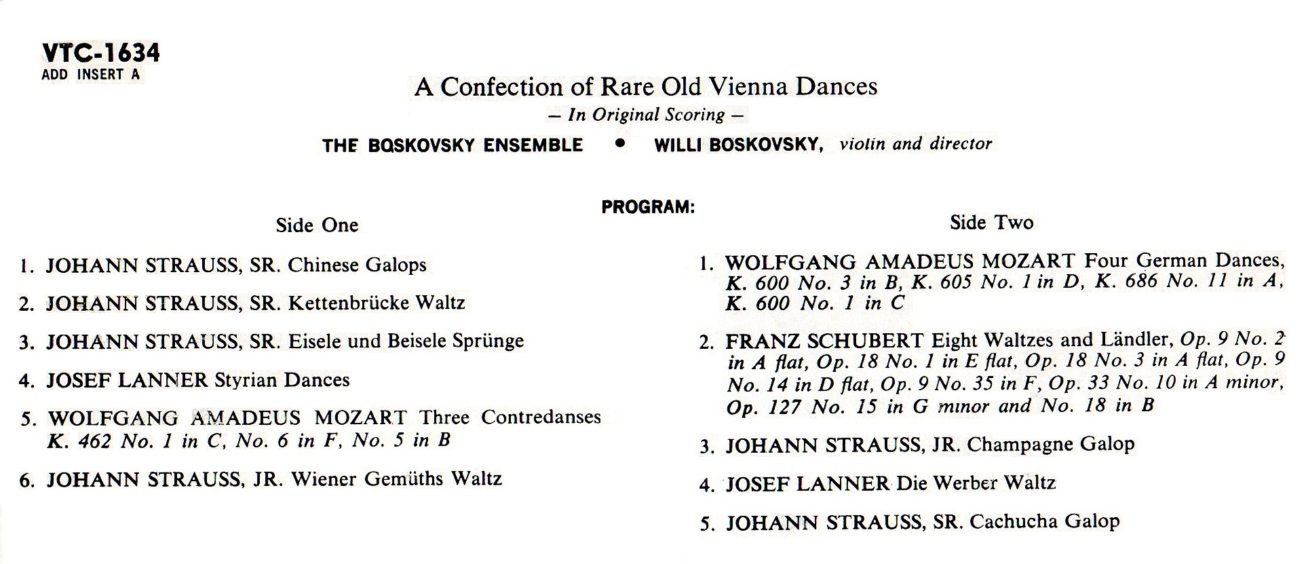
Among the works by Johann Strauss Sr (1804- 1849), we find one of his first great ‘hits’, the ‘Kettenbrücke Walzer’, composed in 1828 to celebrate the first chain suspension bridge in Vienna, built near the ‘Rasumovsky Palais’ and inaugurated in 1825, a rather unexpected subject for a waltz!
Then, the Strauss Family era took over shortly after Haydn, Mozart, Beethoven and Schubert who also composed popular music.
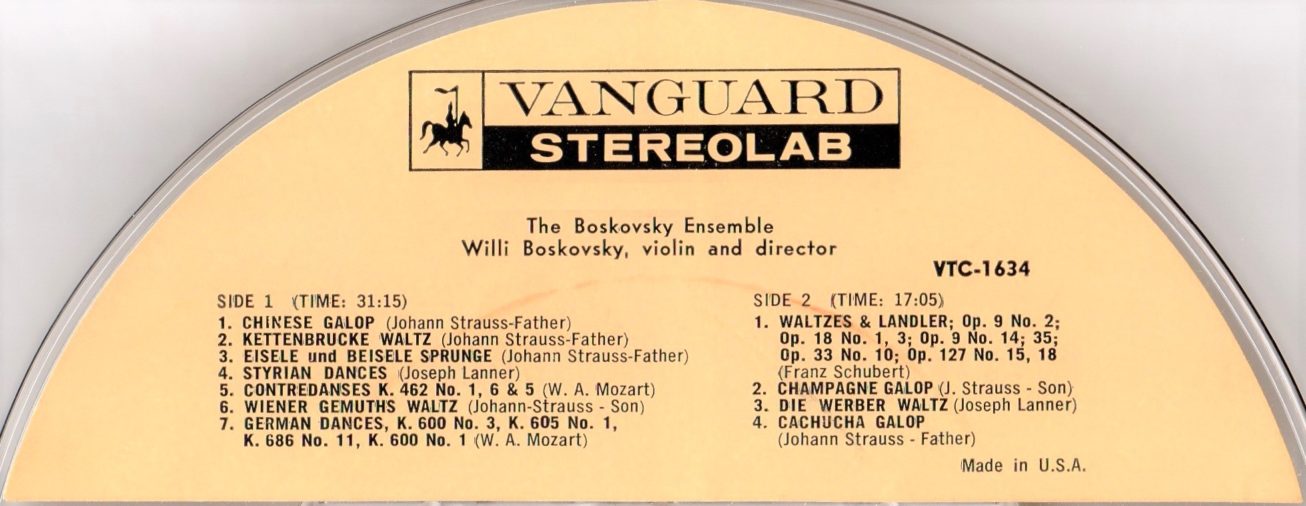
Les liens de téléchargement sont dans le premier commentaire. The download links are in the first comment.

